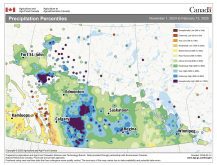Risk is a basket of deplorable possibilities, while reward is a simple package of profits.
It’s easy to see the rewards when they appear. There’s something black sitting in the account after a few months of marketing.
Risks are scattered across that misty field known as “the future,” with little pattern but with bad intent.
It’s hard to get all those scattered risks collected and in front of you so that you can hedge against them, but it’s something the folks at Manitoba Agriculture’s Farm Management team spend their time trying to achieve, and they do a great job.
Read Also

Organic farmers urged to make better use of trade deals
Organic growers should be singing CUSMA’s praises, according to the Canadian Chamber of Commerce.
Each year I look forward to seeing their new crop production profitability projections.
What’s valuable about their work is that they don’t just give a good guess about what profits crops are going to bring this year, based on their costs of production, but also offer an array of assessing the risks farmers are taking by growing those particular crops.
(It doesn’t matter if you don’t live in Manitoba to get the benefit from their risk assessment thinking. Just plug in your own numbers.)
This year their assessment of some crucial risks is laid out in a pleasing centrefold (post on your office wall) of charts. They break apart various ways of looking at crop production risk, probably ways that most farmers seldom employ.
One is “80 Percent Insured Value AgriInsurance Risk,” which compares insured cost versus operating and total costs. Another is a return-on-investment comparison to crop insurance coverage.
They look at break-even yields versus reasonable-expectation yields. They chart seeding date versus likely profitability.
My favourite part of their work is the “Stress Test” section, where they subject reasonable expectations of yield and price to a 10 percent drop in price and a five percent drop in yield.
That measure can offer a helpful slap-in-the-face picture of the risk a farmer is facing by seeding any particular crop in the spring and is a picture of the way a farmer should be thinking about risk.
Most farmers have a good, instinctive grasp of these risks when they’re assessing their crop options and risk management for a coming year. Often the best kind of wisdom is the “gut feeling” we all get when looking at complicated matters that are hard to deconstruct and still comprehend as a whole.
But it’s a good thing for farmers that people like those at Manitoba Agriculture’s Farm Management team are breaking these things apart and allowing us to look at slices of the situation.
Risk is complicated and it’s less fun to think about than reward. It’s nice to have somebody tearing this stuff apart so we can look at it without doing much work ourselves.















